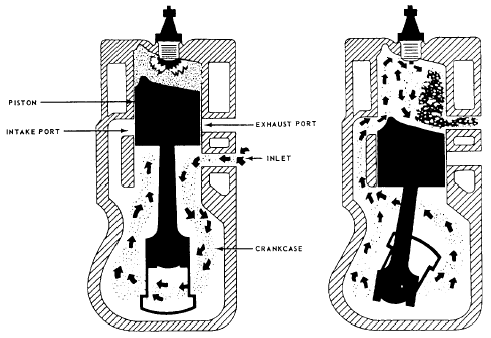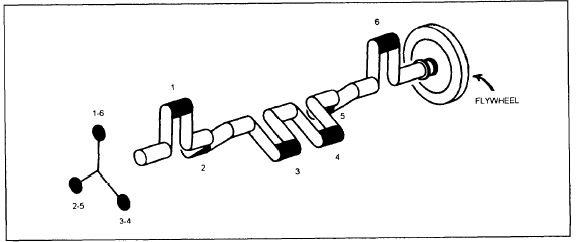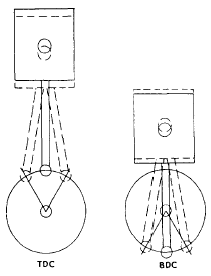ENGINE CYCLES
Now, with the basic knowledge you have of the parts and the four strokes of the engine, let us see what happens during the actual running of the engine. To produce sustained power, an engine must repeatedly complete one series of the four strokes: intake, compression, power, and exhaust. One completion of this series of strokes is known as a cycle.
Most engines of today operate on four-stroke cycles, although we use the term four-cycle engines to refer to them. The term actually refers to the four strokes of the piston, two up and two down, not the number of cycles completed. For the engine to operate, the piston continually repeats the four-stroke cycle.
TWO-CYCLE ENGINE
In the two-cycle engine, the entire series of strokes (intake, compression, power, and exhaust) takes place in two piston strokes.

-Events in a two-cycle, internal combustion engine.
is engine is a power stroke. Each time the piston moves down, it is on the power stroke. Intake, compression, power, and exhaust still take place; but they are completed in just two strokes. Figure 12-5 shows that the intake and exhaust ports are cut into the cylinder wall instead of at the top of the combustion chamber as in the four-cycle engine. As the piston moves down on its power stroke, it first uncovers the exhaust port to let burned gases escape and then uncovers the intake port to allow a new fuel-air mixture to enter the combustion chamber. Then on the upward stroke, the piston covers both ports and, at the same time, compresses the new mixture in preparation for ignition and another power stroke.
In the engine shown in figure 12-5, the piston is shaped so that the incoming fuel-air mixture is directed upward, thereby sweeping out ahead of it the burned exhaust gases. Also, there is an inlet into the crankcase through which the fuel-air mixture passes before it enters the cylinder. This inlet is opened as the piston moves upward, but it is sealed as the piston moves downward on the power stroke. The downward moving piston slightly compresses the mixture in the crankcase. That gives the mixture enough pressure to pass rapidly through the intake port as the piston clears this port. This action improves the sweeping-out, or scavenging, effect of the mixture as it enters and clears the burned gases from the cylinder through the exhaust port
FOUR-CYCLE VERSUS TWO-CYCLE ENGINES
You have probably noted that the two-cycle engine produces a power stroke every crankshaft revolution; the four-cycle engine requires two crankshaft revolutions for each power stroke. It might appear that the two-cycle engine could produce twice as much power as the four-cycle engine of the same size, operating at the same speed. However, that is not true. With the two-cycle engine, some of the power is used to drive the blower that forces the air-fuel charge into the cylinder under pressure. Also, the burned gases are not cleared from the cylinder. Additionally, because of the much shorter period the intake port is open (compared to the period the intake valve in a four-stroke-cycle is open), a smaller amount of fuel-air mixture is admitted. Hence, with less fuel-air mixture, less power per power stroke is produced compared to the power produced in a four-stroke cycle engine of like size operating at the same speed and under the same conditions. To increase the amount of fuel-air mixture, we use auxiliary devices with the two-stroke engine to ensure delivery of greater amounts of fuel-air mixture into the cylinder.

-Crankshaft for a six-cylinder engine.
MULTIPLE-CYLINDER ENGINES
The discussion so far in this chapter has concerned a single-cylinder engine. A single cylinder provides only one power impulse every two crankshaft revolutions in a four-cycle engine. It delivers power only one-fourth of the time. To provide for a more continuous flow of power, modem engines use four, six, eight, or more cylinders. The same series of cycles take place in each cylinder.
In a four-stroke cycle, six-cylinder engine, for example, the cranks on the crankshaft are set 120 degrees apart. The cranks for cylinders 1 and 6, 2 and 5, and 3 and 4 are in line with each other (fig. 12-6). The cylinders fire or deliver the power strokes in the following order: 1-5-3-6-2-4. Thus, the power strokes follow each other so closely that a continuous and even delivery of power goes to the crankshaft.
TIMING
In a gasoline engine, the valves must open and close at the proper times with regard to piston position and stroke. In addition, the ignition system must produce the sparks at the proper time so that the power strokes can start. Both valve and ignition system action must be properly timed if good engine performance is to be obtained.
Valve timing refers to the exact times in the engine cycle that the valves trap the mixture and then allow the burned gases to escape. The valves must open and close so that they are constantly in step with the piston movement of the cylinder they control. The position of the valves is determined by the camshaft; the position of the piston is determined by the crankshaft. Correct valve timing is obtained by providing the proper relationship between the camshaft and the crankshaft.
When the piston is at top dead center, the crankshaft can move 15° to 20° without causing the piston to move up and down any noticeable distance. This is one of the two rock positions (fig. 12-7) of the piston. When the piston moves up on the exhaust stroke, considerable momentum is given to the exhaust gases as they pass out through the exhaust valve port. If the exhaust valve closes at top dead center, a small amount of the gases

-Rock position.
will be trapped and will dilute the incoming fuel-air mixture when the intake valves open. Since the piston has little downward movement while in the rock position, the exhaust valve can remain open during this period and thereby permit a more complete scavenging of the exhaust gases.
Ignition timing refers to the timing of the sparks at the spark plug gap with relation to the piston position during the compression and power strokes. The ignition system is timed so that the sparks occurs before the piston reaches top dead center on the compression stroke. That gives the mixture enough time to ignite and start burning. If this time were not provided, that is, if the spark occurred at or after the piston reached top dead center, then the pressure increase would not keep pace with the piston movement.
At higher speeds, there is still less time for the fuel-air mixture to ignite and bum. To make up for this lack of time and thereby avoid power loss, the ignition system includes an advance mechanism that functions on speed.